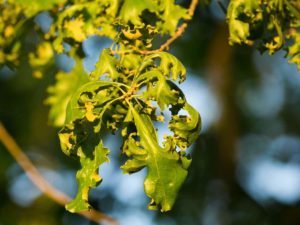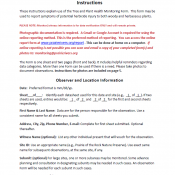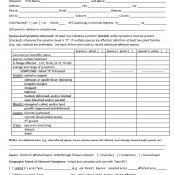
Prairie Rivers Network is deeply concerned about the health of trees and ecosystems across Illinois, as a result of years of damage from drifting herbicides.
Beginning in 2018, Prairie Rivers Network created the Tree and Plant Health Monitoring Program to ensure that someone is monitoring the health of ecosystems under the pressures of habitat loss, pesticides, and climate change.
In July 2024, we released the results of six years of monitoring in the report, Hidden in Plain Sight.
The report found that more than 99 percent of sites we monitored exhibited signs of herbicide exposure, and more than 90 percent of trees tested had detectable levels of herbicide residue. The report shared the stories of people whose lives have been impacted by this herbicide drift.
We’ve been documenting this damage for years. You can read our 2018-2019 Tree and Plant Health Monitoring Report. We also co-published a report with the National Wildlife Federation, and the Xerces Society for Invertebrate Conservation titled Drifting Toward Disaster: How Dicamba Herbicides are Harming Cultivated and Wild Landscapes. This 2020 report reviews the state of the science on the potential far-reaching impacts of dicamba use.
Herbicide drift is nothing new, but we’ve never seen it at this level before.
In recent years, Illinois been dealing with large increases in reports of injuries to crops, trees, and plants. These injuries are symptomatic of exposure to plant growth regulator (PGR) herbicides such as 2,4-D and dicamba, which are commonly used in agriculture and lawn management. Even moderate levels of repeated and/or chronic exposures can injure plants and have not only visible, but also unseen effects on our environment.
Paying attention to what is happening on your property and documenting and reporting symptoms if you see them is important. The video below is designed to help people recognize symptoms of PGR exposure in crops, trees, and other wild plants and provides information on how and where to document or report symptoms. Below the video is more information about our Tree and Plant Health Monitoring Program.
You can also view a photo library of symptoms here.
This page contains information about our Tree and Plant Health Monitoring Program. Please note: Personal information on the monitoring forms will NOT be shared publicly and is for the sole purpose of data verification.
We thank you for your assistance in keeping an eye out for the biodiversity of Illinois and we welcome your feedback. Questions can be sent to monitoring@prairierivers.org.
DAMAGE TO ILLINOIS’ RECORD-SETTING POST OAK
Many trees are showing symptoms of exposure to herbicide drift and volatilization (think evaporation and movement), including our state record-setting Post Oak:
REPORTING SYMPTOMS OF HERBICIDE DAMAGE TO IDOA
If you notice herbicide injury on your plantings or on non-target species you can report it to the Illinois Department of Agriculture at “Pesticides: Uses & Misuses.”
Also, call IDOA’s Bureau of Environmental Programs at 1-800-641-3934 (voice and TDD) or 217-785-2427 for a complaint form. Complaints must be received by the IDOA within 30 days of the incident or within 30 days of when the damage was first noticed. Complaints filed after that will be kept on record, but no administrative action can be taken.
The complaint process is not set up to address all cases of potential herbicide related injury to plants. It is becoming more clear with each passing year that the current pesticide complaint system has numerous limitations and problems. However, it is currently the primary way that IDOA collects information regarding pesticide-related injuries and therefore remains an important (and the public’s only) method of documenting suspected injury with the IDOA.
MONITORING AND REPORTING SYMPTOMS WITH PRN
It is apparent that we must gain a better understanding of the geographic range, extent, and severity of symptoms. To that end, using the talents and strengths of valuable members and partners, we have developed monitoring guidelines, protocols, and data collection forms, as well as an online reporting system where you can submit documentation of symptoms. For a more in depth tutorial of how to monitor a site for symptoms of off-target herbicide injury, please view the training webinar.
The PRN monitoring forms below are intended to be used by anyone interested in documenting potential herbicide injury to trees and other broadleaf plants. It is our hope that information gleaned from this monitoring effort will help landowners, managers, and scientists better understand what is happening on the landscape and possibly serve as justification for a closer, more in-depth study of this issue by state and federal agencies and/or research institutions.
By helping us keep track of potential herbicide damage to non-target species you will be helping increase the “eyes on the trees and boots on the ground” and drastically improve our ability to document injury to species on a statewide level.
Printable Tree and Plant Health Monitoring Forms
If you choose not to watch the webinar, but still want to document suspected injury to your property please read the monitoring instructions and use the data recording form.
Forms and photographs can be filed on our online reporting system or they can be emailed to monitoring@prairierivers.org
Please note: When reporting symptoms to PRN you will need the following items:
- A camera to document the symptoms (photo is required)
- GPS point of monitoring location (can be obtained from map on smartphone)
- Binoculars (to see higher up in the tree canopy)
- Tree/plant ID book
- Bug repellent & sunscreen
- Permission to be on property
ONLINE REPORTING SYSTEM
(must have Google account to use)
The preferred method of reporting is the digital report form. A Gmail or Google account is required for the online reporting form in order to submit images of the symptoms.









